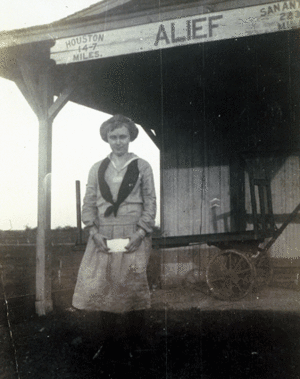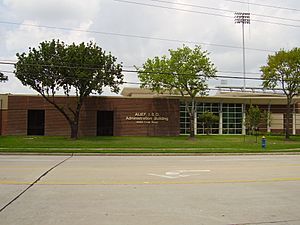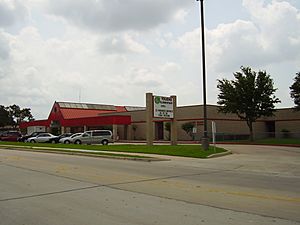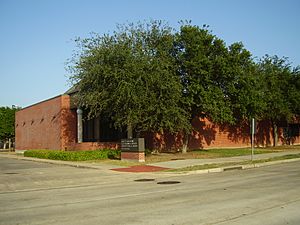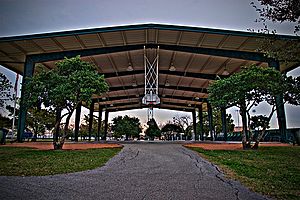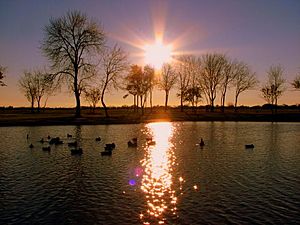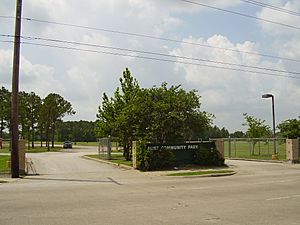Alief, Houston facts for kids
Quick facts for kids
Alief
|
|
|---|---|
| Country | |
| State | |
| County | Harris |
| City | |
| Settled | 1894 |
| Annexed by Houston | 1967 |
| Area | |
| • Total | 36.6 km2 (14.13 sq mi) |
| Elevation | 24 m (79 ft) |
| Population
(2015)
|
|
| • Total | 106,657 |
| • Density | 2,914.4/km2 (7,548.3/sq mi) |
| Time zone | UTC-6 (CST) |
| • Summer (DST) | UTC-5 (CDT) |
| ZIP codes |
77411, 77099, 77072
|
| Area codes | 281, 346, 713, 832 |
| GNIS feature ID | 1329364 |
Alief (/ˈeɪliːf/ AY-leef) is a busy community in Southwest Harris County, Texas. Most of Alief is part of the city of Houston. A smaller part is in the surrounding Harris County area.
Alief started as a farming community in 1894. It grew very quickly in the 1970s and 1980s. Today, Alief is known for being one of the most diverse areas in Houston. Many different cultures and backgrounds call Alief home.
Contents
- Alief's Story: A Look Back in Time
- Alief's Layout: Where Things Are
- People and Cultures in Alief
- Learning in Alief: Schools and Libraries
- Keeping Alief Safe: Emergency Services
- Staying Healthy: Medical Services
- Getting Around Alief: Transportation
- Fun and Outdoors: Parks and Recreation
- Faith in Alief: Religious Places
- Fun Events and Celebrations
- See Also
Alief's Story: A Look Back in Time
How Alief Began (1861–1917)
In 1861, a large piece of land near Brays Bayou was claimed. This land was later sold to Francis Meston in 1893. He planned to build a community there. In 1894, the new town was officially recognized by Harris County. It was first called Dairy, Texas.
The first settlers were Dr. John S. Magee and his wife, Alief Ozelda Magee. They moved to Dairy in 1894. Alief Ozelda Magee became the town's first postmistress. She opened the first post office in 1895. The postal service named the office "Alief" in her honor. This helped avoid confusion with another town called Daisy, Texas. Her home, where the post office was, received a special historical marker in 1990.
Sadly, Alief Ozelda Magee passed away in 1899. She was buried in the Alief Cemetery. This cemetery is now at the corner of Bellaire Blvd. and Dairy Ashford. It also has a historical marker.
In 1899 and 1900, big floods and a hurricane hit the town. Many families had to leave. The town became like a prairie again. But Jacamiah Seaman Daugherty, who had owned the land earlier, helped the remaining families. He showed them that rice could grow well in the flooded areas. Rice became a successful crop, and many people returned to Alief. In 1901, the first Germans immigrated to Alief. By 1904, most of the families who had left came back. This growth led to a new depot being built.
Because of the floods, the Harris County Flood Control District was created in Alief in 1909. In 1911, the Dairy School District was formed, and a three-story school was built. The town was officially renamed "Alief, Texas" in 1917. The school district also became the Alief Independent School District (Alief ISD).
Alief Grows and Changes (1918–1969)
Cars started to arrive in Alief around 1920. A canal called the Cane Belt Canal was finished in 1934. It helped rice farmers with irrigation. Alief got electricity in 1935.
Schools in Alief were once separated by race. From 1927 to 1937, African American children went to school in the Prairie Grove Missionary Baptist Church. Before that, they used a one-room schoolhouse. David E. Outley, an African American educator, created this schoolhouse. A school is now named after him in Alief.
The population of Alief changed a lot during this time. It was as low as 35 people in the 1930s but grew to 200 by 1942. Alief got telephone service in 1943. A small airport, Andrau Airpark, opened in 1946. In 1964, Alief ISD built Alief Elementary School, which is still standing today.
Fast Growth and New Faces (1970–1989)
In 1970, Alief was mostly open land. But Houston started to expand westward, and Alief grew quickly. Many new people moved to the area looking for homes. The population of Alief grew four times bigger between 1970 and 1985! The Alief Independent School District had to work hard to find space for all the new students.
As Alief grew, it became much more diverse. In 1978, most people were white. But by the 1980s, many Spanish-speaking immigrants and African Americans moved to Alief. Many people of Asian descent also settled in Alief. This included immigrants from China, the Philippines, India, Pakistan, Vietnam, Cambodia, and Korea. By the late 1980s, white students were less than half of the students in Alief ISD.
Houston started to make parts of Alief part of the city in 1977. This process continued into the 1980s. Farmers stopped growing cotton and other crops as the area became more urban. New buildings and businesses took their place. In 1985, Houston Fire Station #76 opened in Alief. The Alief Branch Library also opened in 1985. The library staff spoke many languages, showing how diverse the community was. West Oaks Mall opened in 1984. A big entertainment complex called Fame City (later Fun Plex) opened in 1986. It had roller skating, movies, mini-golf, and a water park!
Continuing to Grow (1990–2010)
Alief's population continued to grow and become even more diverse. From 1990 to 2005, the population increased by 45%. By 1991, Alief ISD was adding about 1,500 new students each year. Students in the district spoke 57 different languages by 1996! The main high schools, Hastings and Elsik, were the two largest in Texas.
By 1997, some street signs in Alief had both English and Chinese names. This showed the growing Asian community. The Hong Kong City Mall opened in 1999, becoming a center for Asian businesses. As more people from different backgrounds moved in, some white residents moved to newer suburbs. This was often because they could afford homes with more features and better schools further away.
Many changes happened in education during the 1990s. In 1993, Alief ISD made passing a state test a requirement for high school graduation. In 1995, voters approved building new ninth-grade centers for Hastings and Elsik high schools. In 1998, funds were approved for a new high school, which became Alief "Doc" Taylor High School.
In 1996, the Henington-Alief Library started offering free internet access to the public. This helped people who didn't have computers at home.
In 2005, Alief welcomed many people who had to leave their homes because of Hurricane Katrina. More than 3,000 evacuees enrolled in Alief ISD schools. The district spent a lot of money to help these students.
Alief's Layout: Where Things Are
The Alief Community Association describes Alief's borders. They say it's between Westheimer to the north, Sam Houston Tollway to the east, the Fort Bend County Line to the west, and Interstate 69/U.S. Highway 59 to the south. The Alief Independent School District boundaries go even further east in some places.
People and Cultures in Alief
Alief is known for its amazing diversity. In 2015, the Houston part of Alief had over 106,000 people. Almost half were Hispanic, about a quarter were non-Hispanic black, and nearly a fifth were non-Hispanic Asian. Only a small percentage were non-Hispanic white.
The Alief Independent School District reported in 2011 that students in the district speak more than 80 different languages! This shows how many different cultures live in Alief. The number of Asian and Hispanic residents in Alief grew a lot between 2000 and 2009.
Learning in Alief: Schools and Libraries
Schools for All Ages
Most students in Alief go to public schools run by the Alief Independent School District (Alief ISD).
As of 2011, Alief ISD has 24 elementary schools. Most students go to an intermediate school for fifth and sixth grade. The district also has six middle schools for grades six through eight. For high school, students are chosen by a lottery to attend either Alief Elsik High School, Alief Hastings High School, or Alief Taylor High School. They can also apply to Alief Kerr High School. Ninth-grade students at Hastings and Elsik go to special Ninth Grade Centers.
Alief ISD also has Alief Early College High School. This school, opened in 2010, lets students earn both a high school diploma and a college associate degree at the same time! The district also has alternative schools for students who need different learning environments.
Some parts of Alief that are in Fort Bend County go to schools in the Fort Bend Independent School District.
Other Schools
Alief also has several charter schools. These are public schools that are not part of the main school districts.
- Alief Montessori Community School (Pre-K to 5th grade)
- Harmony Public Schools (Harmony School of Innovation and Harmony Science Academy High)
- Knowledge Is Power Program (KIPP) (KIPP SHINE Preparatory, KIPP Academy Middle School, KIPP Houston High School, and KIPP Unity)
There are also private schools in Alief:
- Christ the Lord Lutheran School (Preschool to 8th grade)
- The Darul Arqam Schools Southwest Campus
College and Higher Education

The Houston Community College System (HCCS) has been in Alief since 1982. The main HCC Alief Campus is located on Hayes Road. There's also the HCC Alief Continuing Education Center for adult learning.
Public Libraries
Alief has libraries from both the Houston Public Library and the Harris County Public Library.
The David M. Henington-Alief Regional Branch of Houston Public Library is in Alief. It was named after David M. Henington, who was the director of the Houston Public Library for many years. The Judson W. Robinson-Westchase Neighborhood Library is also nearby.
Residents in the Harris County part of Alief can get library cards for the Harris County Public Library system.
Keeping Alief Safe: Emergency Services
Fire and Medical Help
If you live in Houston's Alief area, the Houston Fire Department provides fire services. Station 76 Alief Community has been serving the area since 1985.
For residents in the unincorporated (not part of a city) Harris County area, the Community Volunteer Fire Department (CVFD) provides fire and emergency medical services. They have two stations and a training center in Alief.
Police Services
The Houston Police Department serves the Alief area within Houston. Their Westside Patrol Division is located on South Dairy Ashford Road.
The Harris County Sheriff's Office serves the parts of Alief that are not in Houston.
The Alief ISD Police Department is a special police force that keeps students, staff, and schools safe within the Alief Independent School District.
Staying Healthy: Medical Services
Hospitals
West Houston Medical Center is a hospital located on West Houston Center Blvd. It was built in 1985. This hospital has many doctors, employees, and beds. It offers an emergency room, heart services, a women's center, a cancer center, and more.
Getting Around Alief: Transportation
Public Transportation
The Metropolitan Transit Authority (METRO) provides local bus services in Alief.
METRO also has Park & Ride locations where you can park your car and take a bus to other parts of Houston. Some of these are in or near Alief, like Gessner Park & Ride, Mission Bend Park & Ride, Westchase Park & Ride, and Westwood Park & Ride.
Major Roads
Several important highways and toll roads pass through or near Alief:
Airports
Andrau Airpark was an airport that operated in Alief from 1946 to 1998. It was closed to make way for a country club and homes.
Fun and Outdoors: Parks and Recreation
Alief has many public parks maintained by both Harris County and the City of Houston.
Harris County Parks
- Alief-Amity Park: This park is about 11 acres and has basketball courts. It's located next to Alief Elsik High School.
- Archbishop Joseph A. Fiorenza Park: This park has a walking trail. It's named after a local archbishop.
- Arthur Storey Park: This large 175-acre park is along Brays Bayou. It's known for its green space and is near Chinatown. It's named after Arthur L. Storey Jr., who helped improve flood control in the county.
- Mike Driscoll Park: This 46-acre park has a playground and a walking trail.
City of Houston Parks
- Alief Community Park: This 37-acre park has a community center and a pool. It also has basketball courts, tennis courts, baseball fields, playgrounds, and trails.
- Boone Park: This park has a walking trail, a cricket field, a playground, and picnic areas. It also has a nature preserve.
- Hackberry Park: This park features a walking trail, a community center, a sprayground (a water play area), and a playground. It used to be a golf course.
- Harwin Park: This park has multi-purpose fields, trails, and a playground.
Faith in Alief: Religious Places
Christian Churches
The Roman Catholic Archdiocese of Galveston-Houston has several churches in Alief:
- Notre Dame Church: Opened in 1969, it has grown to serve many families.
- Ascension Chinese Mission: This church started with Chinese worship services in the 1970s.
- Christ, The Incarnate Word Church: This is one of several Vietnamese Catholic churches in Houston.
- St. Justin Martyr
Wilcrest Baptist Church is also in the area.
Other Religions
- Shri Krishna Vrundavana: This Hindu temple is located in the Alief area. It started in 2011 and has grown to serve over 800 people.
- Masjid At-Taqwa (Synott Islamic Center): This mosque is operated by the Islamic Society of Greater Houston (ISGH). In the 2000s, Alief had one of the highest percentages of Muslims in the Houston area.
Fun Events and Celebrations
Lunar New Year Festival
The Lunar New Year Festival is an annual event that started in 1996. It features dancing, cooking, and sometimes a beauty contest. It's known as a big international celebration in the southwest Houston area.
International Parade
The International Parade started in 2008. It happens every year in late September. The parade aims to include many different ethnic groups and celebrate the community's diversity. The parade route goes down Bellaire Blvd.
|
See Also
- Alief Independent School District
- Houston Community College System
- Westchase, Houston




